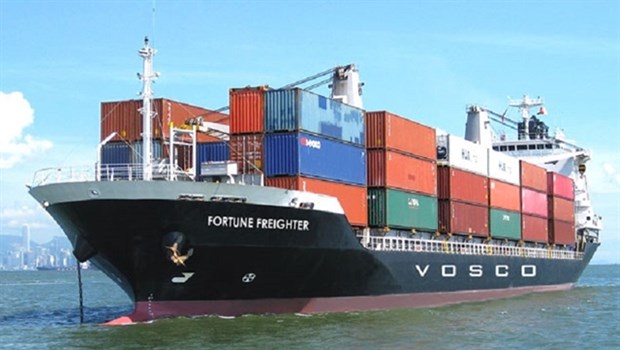High costs are putting obstacles in the way of ocean carriers trying to go green, heard a seminar on sustainable maritime transporation last week.

A VOSCO container carrier (Photo: vosco.vn)
High costs are putting obstacles in the way of ocean carriers trying to go green, heard a seminar on sustainable maritime transporation last week.
A representative from the Vietnam Maritime Corporation (VIMC) said the Carbon Intensity Indicator (CII) measures how efficiently a vessel transports goods and passengers.
CII is calculated in grams of CO2 emitted per cargo-carrying capacity and nautical miles, and is categorised into five levels: A (major superior), B (minor superior), C (moderate), D (minor inferior), and E (inferior performance level).
To receive a rating of C, a vessel must cut CO2 emissions in three consecutive years from 2023 to 2026 by 2% per year, which cannot be done without engine upgrades and the use of LNG or Methanol in place of HFO fuels.
Unfortunately, the conversions are beyond the financial capability of most Vietnamese shippers, leaving them with no choice but to run some of their vessels at a lower capacity and idle some others to comply with CII standards.
“The conversions are unfeasible for Vietnamese shippers as well as other small-scale shippers in the world owing to high costs“, said the representative.
The representative was concerned that the conflict between the global fleet rejuvenation required by CII standards and the shippers’ financial situation would result in a bottleneck in maritime transportation worldwide.
From January 1, 2023, it is mandatory for all vessels to calculate their attained Energy Efficiency Existing Ship Index (EEXI) to measure their energy efficiency and to initiate the collection of data for the reporting of their CII and CII ratings.
VIMC has sent an appeal to the International Maritime Organisation, asking for different time frames for vessels in different regions to give small-scale carriers more time to adapt to the new system.
For instance, carriers in developing countries would need longer time frames to replace their sub-standard vessels with new green ones. Too abrupt a transition could lead to mass bankruptcies among those in weak financial position.
IMO Secretary-General Kitack Lim said IMO raised the target of greenhouse gas emission reduction in maritime transportation to keep pace with the global action on green growth.
As such, his organisation is eager to support Vietnamese carriers in the effort to improve their energy efficiency and reduce their environmental impact. He also believes that Việt Nam will do a good job in the green transition given the country’s fast economic growth and long coastline.
A representative from the Vietnam Ocean Shipping JSC (VOSCO) said the CII-compliant costs incurred by global carriers could amount to 3 trillion USD in the next decades.
He also said the “going green” in martime transportation would require various country-specific strategies rather than an universal stragegy for all./.
en.vietnamplus.vn
